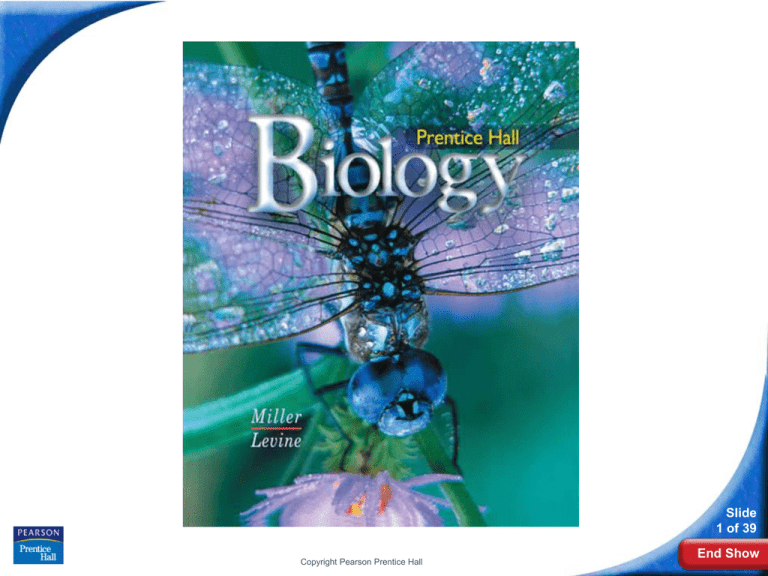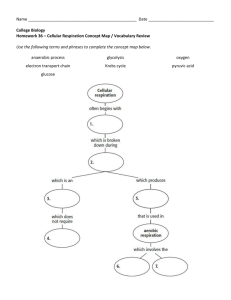
Biology
Slide
1 of 39
Copyright Pearson Prentice Hall
End Show
9-1 Chemical Pathways
Slide
2 of 39
Copyright Pearson Prentice Hall
End Show
9-1 Chemical Pathways
9-1 Chemical Pathways
Food serves as a source of raw materials for the
cells in the body and as a source of energy.
Animal Cells
Animal
Mitochondrion
Plant
Plant Cells
Copyright Pearson Prentice Hall
Slide
3 of 39
End Show
9-1 Chemical Pathways
Both plant and animal cells carry out the final
stages of cellular respiration in the mitochondria.
Animal Cells
Outer membrane
Intermembrane
Mitochondrion
space
Inner
membrane
Matrix
Plant Cells
Copyright Pearson Prentice Hall
Slide
4 of 39
End Show
9-1 Chemical Pathways
Chemical Energy and Food
Chemical Energy and Food
One gram of the sugar glucose (C6H12O6), when
burned in the presence of oxygen, releases 3811
calories of heat energy.
A calorie is the amount of energy needed to raise
the temperature of 1 gram of water 1 degree
Celsius.
Slide
5 of 39
Copyright Pearson Prentice Hall
End Show
9-1 Chemical Pathways
Overview of Cellular Respiration
What is cellular respiration?
Slide
6 of 39
Copyright Pearson Prentice Hall
End Show
9-1 Chemical Pathways
Overview of Cellular Respiration
Electrons carried in NADH
Electrons carried
in NADH and
FADH2
Pyruvic
acid
Glucose
Glycolysis
Cytoplasm
Mitochondrion
Slide
7 of 39
Copyright Pearson Prentice Hall
End Show
9-1 Chemical Pathways
Overview of Cellular Respiration
Cellular respiration is the process that
releases energy by breaking down
glucose and other food molecules in the
presence of oxygen.
Slide
8 of 39
Copyright Pearson Prentice Hall
End Show
9-1 Chemical Pathways
Overview of Cellular Respiration
The equation for cellular respiration is:
6O2 + C6H12O6 → 6CO2 + 6H2O + Energy
oxygen + glucose → carbon dioxide + water + Energy
Slide
9 of 39
Copyright Pearson Prentice Hall
End Show
9-1 Chemical Pathways
Overview of Cellular Respiration
Glycolysis takes place in the cytoplasm. The
Krebs cycle and electron transport take place in
the mitochondria.
Glycolysis
Cytoplasm
Mitochondrion
Slide
10 of 39
Copyright Pearson Prentice Hall
End Show
9-1 Chemical Pathways
Glycolysis
What happens during the process of
glycolysis?
Slide
11 of 39
Copyright Pearson Prentice Hall
End Show
9-1 Chemical Pathways
Glycolysis
ATP Production
At the beginning of glycolysis, the cell uses up 2
molecules of ATP to start the reaction.
2 ATP
2 ADP
4 ADP
4 ATP
Glucose
2 Pyruvic
acid
Slide
12 of 39
Copyright Pearson Prentice Hall
End Show
9-1 Chemical Pathways
Glycolysis
When glycolysis is complete, 4 ATP molecules
have been produced.
2 ATP
2 ADP
4 ADP
4 ATP
Glucose
2 Pyruvic
acid
Slide
13 of 39
Copyright Pearson Prentice Hall
End Show
9-1 Chemical Pathways
Glycolysis
This gives the cell a net gain of 2 ATP molecules.
2 ATP
2 ADP
4 ADP
4 ATP
Glucose
2 Pyruvic
acid
Slide
14 of 39
Copyright Pearson Prentice Hall
End Show
9-1 Chemical Pathways
Glycolysis
NADH Production
One reaction of glycolysis removes 4 high-energy
electrons, passing them to an electron carrier
called NAD+.
2 ATP
2 ADP
4 ADP
4 ATP
Glucose
2NAD+
2 Pyruvic
acid
Slide
15 of 39
Copyright Pearson Prentice Hall
End Show
9-1 Chemical Pathways
Glycolysis
Each NAD+ accepts a pair of high-energy electrons
and becomes an NADH molecule.
2 ATP
2 ADP
4 ADP
4 ATP
Glucose
2NAD+
2
2 Pyruvic
acid
Slide
16 of 39
Copyright Pearson Prentice Hall
End Show
9-1 Chemical Pathways
Glycolysis
The NADH molecule holds the electrons until they
can be transferred to other molecules.
2 ATP
2 ADP
4 ADP
2NAD+
4 ATP
2
2 Pyruvic
acid
To the electron
transport chain
Copyright Pearson Prentice Hall
Slide
17 of 39
End Show
9-1 Chemical Pathways
Glycolysis
The Advantages of Glycolysis
The process of glycolysis is so fast that cells can
produce thousands of ATP molecules in a few
milliseconds.
Glycolysis does not require oxygen.
Slide
18 of 39
Copyright Pearson Prentice Hall
End Show
9-1 Chemical Pathways
Fermentation
Fermentation
When oxygen is not present, glycolysis is followed
by a different pathway. The combined process of
this pathway and glycolysis is called fermentation.
Fermentation releases energy from food
molecules by producing ATP in the absence of
oxygen.
Slide
19 of 39
Copyright Pearson Prentice Hall
End Show
9-1 Chemical Pathways
Fermentation
During fermentation, cells convert NADH to NAD+
by passing high-energy electrons back to pyruvic
acid.
This action converts NADH back into NAD+, and
allows glycolysis to continue producing a steady
supply of ATP.
Fermentation does not require oxygen—it is an
anaerobic process.
Slide
20 of 39
Copyright Pearson Prentice Hall
End Show
9-1 Chemical Pathways
Fermentation
What are the two main types of
fermentation?
Slide
21 of 39
Copyright Pearson Prentice Hall
End Show
9-1 Chemical Pathways
Fermentation
Alcoholic Fermentation
Yeasts and a few other microorganisms use
alcoholic fermentation, forming ethyl alcohol and
carbon dioxide as wastes.
The equation for alcoholic fermentation after
glycolysis is:
pyruvic acid + NADH → alcohol + CO2 + NAD+
Slide
22 of 39
Copyright Pearson Prentice Hall
End Show
9-1 Chemical Pathways
Fermentation
Lactic Acid Fermentation
In many cells, pyruvic acid that accumulates as a
result of glycolysis can be converted to lactic acid.
This type of fermentation is called lactic acid
fermentation. It regenerates NAD+ so that
glycolysis can continue.
The equation for lactic acid fermentation after
glycolysis is:
pyruvic acid + NADH → lactic acid + NAD+
Slide
23 of 39
Copyright Pearson Prentice Hall
End Show
9-1 Chemical Pathways
Fermentation
The first part of the equation is glycolysis.
Slide
24 of 39
Copyright Pearson Prentice Hall
End Show
9-1 Chemical Pathways
Fermentation
The second part shows the conversion of pyruvic
acid to lactic acid.
Slide
25 of 39
Copyright Pearson Prentice Hall
End Show
9-1
Click to Launch:
Continue to:
- or -
Slide
26 of 39
End Show
Copyright Pearson Prentice Hall
9-1
The raw materials required for cellular
respiration are
a. carbon dioxide and oxygen.
b. glucose and water.
c. glucose and oxygen.
d. carbon dioxide and water.
Slide
27 of 39
End Show
Copyright Pearson Prentice Hall
9-1
Glycolysis occurs in the
a. mitochondria.
b. cytoplasm.
c. nucleus.
d. chloroplasts.
Slide
28 of 39
End Show
Copyright Pearson Prentice Hall
9-1
The net gain of ATP molecules after glycolysis is
a. 3 ATP molecules.
b. 2 ATP molecules.
c. 3 pyruvic acid molecules.
d. 4 pyruvic acid molecules
Slide
29 of 39
End Show
Copyright Pearson Prentice Hall
9-1
Fermentation releases energy from food
molecules in the absence of
a. oxygen.
b. glucose.
c. NADH.
d. alcohol.
Slide
30 of 39
End Show
Copyright Pearson Prentice Hall
9-1
The first step in fermentation is always
a. lactic acid production.
b. the Krebs cycle.
c. glycolysis.
d. alcohol production.
Slide
31 of 39
End Show
Copyright Pearson Prentice Hall
END OF SECTION





